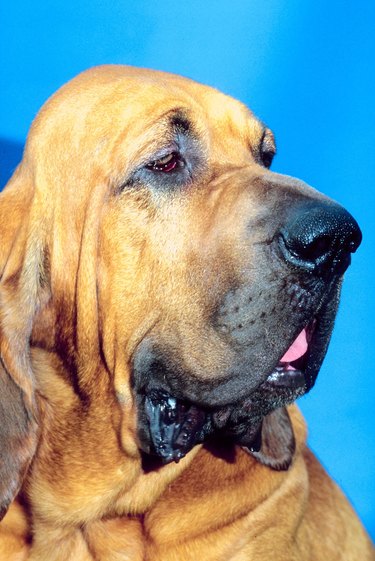
Some dog breeds have been selectively bred for sagging skin for hundreds, if not thousands of years. This sagging skin was considered to enhance the basic skills of the dog. Hunting, tracking and working dogs often have abundant loose skin around their heads and necks. Sagging skin can sometimes cause problems for the dog, in that it traps moisture and bacteria in sensitive areas. In some very rare circumstances, sagging skin is not a characteristic that has been selected for in a breed of dog, but rather is a condition that causes the loss of collagen under the skin.
Hunting and Tracking Dogs
Video of the Day
Hound breeds used for hunting and tracking often have loose, sagging skin. The Basset hound is primarily used for rabbit hunting in the United States, and the Bloodhound, often used for tracking human quarry, both have such skin. These breeds' profuse skin and ear leather is intended to trap the prey's scent so that the dog can more easily locate it. The Basset hound, like many of the scent hound group of dogs, has loose skin over its skull, which according to its AKC standard, falls "in distinct wrinkles over the brow when the head is lowered. The AKC Bloodhound standard places even more emphasis on wrinkle, which has its own section, stating that "in nearly every position [it] appears superabundant, but more particularly so when the head is carried low; the skin then falls into loose, pendulous ridges and fold, especially over the forehead and sides of the face.
Video of the Day
Guard Dogs and Working Dogs
Dogs used for guarding and working tasks also may have sagging skin. Unlike the scenting dogs above, these dogs tend to have loose skin around their necks and lack the long ears of the hunters and trackers. Chinese Shar-Peis, used for general farm work and guarding, have profuse skin on their face and necks, to allow them to turn around in their skin if necessary. The Neapolitan mastiff has similar profuse, sagging skin all over its body. The ancient Romans developed this breed as a war dog, so the natural protection provided by the skin was important to its survival. The "profuse and divided dewlap [that] extends from the lower jaw to the lower neck" is considered such an important feature of the breed that its absence is a disqualification from the show ring.
Caring for Sagging Skin
Dogs with loose, sagging skin need special care to remain healthy. Bloodhounds, in fact, have a characteristic "houndy" odor to them due to the yeast and bacteria that grow in the warm, moist folds of their wrinkles, which also trap dirt. Cleaning once or twice a week between the folds with a gentle cleanser and monthly baths followed by thorough drying of the area can help a dog's skin stay healthy and relatively odor-free. Clean away any scabrous or crusted areas, rinse and dry thoroughly, and apply an ointment or medicated powder to aid healing. Dogs like Pekingese and Pugs, which have wrinkled faces, can also benefit from cleaning between the facial folds either with a gentle cleaner on a soft cloth.
Cutaneous Asthenia
Some breeds of dogs, particularly Beagles, Greyhounds, Manchester terriers (both varieties) and Welsh corgis are affected by a disorder called "cutaneous asthenia." This disorder affects the dog by the time it is six months of age, causing the dog's skin to weaken and stretch. The condition, caused by the lack of collagen in the dog's skin, makes the dog's skin prone to bruising, blistering and easily forming tears that do not bleed. There is no treatment or cure for cutaneous asthenia.
Always check with your veterinarian before changing your pet’s diet, medication, or physical activity routines. This information is not a substitute for a vet’s opinion.
- American Kennel Club; AKC Meet the Breeds: Basset Hound; 1964
- American Kennel Club; AKC Meet the Breeds: Bloodhound; 1996
- American Kennel Club; AKC Meet the Breeds: Neapolitan Mastiff; 2004
- DogChannel.com; Grooming to Make Your bloodhound Beautiful!; Eve Adamson; 2011
- Go Pets America; Pets, Animals, Biology Topics: Cutaneous Asthenia; 2011